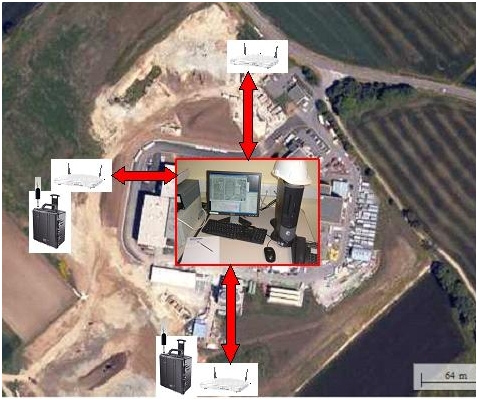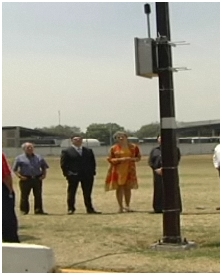Using Wireless Networks for Real-World Noise Measurement Applications
Kurt Veggeberg - kurt.veggeberg@ni.com
National Instruments, Austin, TX
Popular version of paper 1pSPb2
Presented Monday afternoon, October 26, 2009
158th ASA Meeting, San Antonio, TX
Wireless technology like common Wi-Fi extends PC-based data acquisition beyond the limits of cables and wires for distributed noise measurement applications. Wireless noise monitoring systems are just beginning to appear in applications such as construction sites to traffic noise in which running network cables can be difficult. There are many advantages to eliminating cables in remote monitoring applications, but there are also many challenges. As Wi-Fi (IEEE 802.11) standards continue to mature, those challenges are being addressed.
Wi-Fi has a variety of advantages for remote noise monitoring, including range and security. Wi-Fi typically operates on 2.4 GHz which is known as the sweet spot of the radio spectrum in terms of range and data rates. Ranges from 30 to 100 meters with data rates from 54 to 600 Mbps are most common. The range depends on a variety of factors and can be extended significantly via high gain antennas.
Security is a major concern for wireless applications. Early wireless standards did not prevent unauthorized access well. A wireless network is more accessible than a wired network (such as Ethernet) because the data travels through the air. Wi-Fi has evolved to provide better authentication requiring identification before being granted access to the network. Even if data is accessible to an unauthorized user, it is not necessarily intelligible. Data encryption on wireless networks has evolved significantly over the last decade from clear-text broadcasts to 128-bit cryptography. It would take billions of years to decode a signal by brute force encoded with common 128 bit encryption standards.
The advantages of using an off-the-shelf wireless network include lower costs, interchangeable products from different suppliers, and established best practices. The latest version of Wi-Fi, a standard called IEEE-802.11n, was ratified on September 11, 2009 though it has been in use for some time. It offers significantly improved data rates (4 5 times faster than 802.11g) and improved ranges for wireless local area networks comparable to wired networks.
Construction Monitoring
Construction generates community noise and vibration issues and requirements for monitoring noise are growing. Construction companies may also be subject to contractual obligations for monitoring. This makes it important to monitor noise and vibration to avoid misunderstandings and maintain the tranquility of the neighborhood by identifying problems in a timely fashion. Environmental monitoring now also establishes a level for normal sound level for the site before the construction is started, not just maximum levels.
When the Public Health Code on Neighborhood Noise in France was updated in 2006, limits were set on overall sound levels of no more than 5 dB(A) above the normal level during the daytime from 7 am to 10 pm and no more than 3 dB(A) at night from 10 pm to 7 am. There are also now specifications and adjustments for the duration of noise and specifications on levels in octave bands, with more leeway given for lower frequencies that carry long distance.
Construction Monitoring Solution
A system called SAVE (Surveillance of Acoustics and Vibration in the Environment) was developed as a noise and vibration management system for construction site managers to meet these needs. It is based on instrumentation from National Instrument, multiple laptop-based systems in a weatherproof case connected to an outdoor microphone. Accelerometers and geophones are used for making vibration measurements. These are placed throughout a construction site and in nearby buildings. They are then connected wirelessly via Wi-Fi in the laptop to a central server in the construction headquarters.

Figure 1. Components of SAVE system
The central server is connected to the monitoring stations throughout the construction site in locations sensitive to noise and vibration. The system automatically detects and configures the monitoring stations, displays the data and alarms, and downloads the files from the monitoring stations.

Figure 2. SAVE distributed throughout construction site.
The SAVE software was developed in a graphically based software system called LabVIEW and includes tools for making noise measurements according to international standards for sound level measurements, weighting filters, and octave analysis.
Traffic Noise Monitoring
The downtown area of Mexico City has a constant flow of traffic 24 hours a day. The city government decided to monitor and record the noise levels in different parts of the central historical district after the environmental standards were updated in 2006. This is a very popular area for visitors, but complaints on noise are numerous. Traffic is the most annoying noise source. The heavy traffic and activity during rush hours in the morning and evening, along with with special events, produce a noise problem that is difficult to assess and to solve. Current standards are that noise emissions should be no more than 68 db(A) and 65 db(A) at night. Already the noise level in most areas has been measured from 77 db(A) up to 82 db(A), levels that are very annoying and approach thresholds of noise-induced hearing loss with too much exposure.
Dr. Jose Luis Snchez, of the National Polytechnical Institute in Mexico City designed a distributed a wireless monitoring system for the central historical district. The system was based on an industrial PC using LabVIEW for the application program, the Sound and Vibration toolkit and a dynamic signal analyzer. The system is contained in a weatherproof case with an uninterruptible power supply to prevent loss of data if the power drops and is mounted so that the outdoor microphone is 4 meters above the road surface according to accepted standards for traffic noise measurements. The system is designed so it can keep collecting data locally for up to 14 days.

Figure 3. Traffic Noise Monitoring System
The government plans to use the acquired data to identify the worst times and locations for noise. The goal is to develop regulations to control and prevent the noise and promote a healthier environment, bringing the city up to par with other big cities worldwide. The system is also capable of transferring sound files to the central server for the identification of isolated sound sources that cause annoyance.
The original plan was to use the Public Wi-Fi in the district that was newly installed in 2008, but some of nodes had to be converted to a slower 3G system provided by a wireless phone carrier. Using the public network caused conflicts with video data transmissions throughout the city. 3G allows simultaneous use of speech and data services but at data rates 10 percent the speed of Wi-Fi. By reserving certain channels on the Wi-Fi system for the traffic monitoring system, they hope to be able to eliminate the slower 3G connection when they expand it.
Conclusion
Wireless technology extends the concept of PC-based data acquisition for acoustics beyond the limits of cables and wired infrastructure for new remote or distributed measurement applications. Both systems described here are examples of low cost free standing monitoring stations with respect to the central server allowing critical tasks such as alarms to be carried out locally in the event of a disruption of the network.